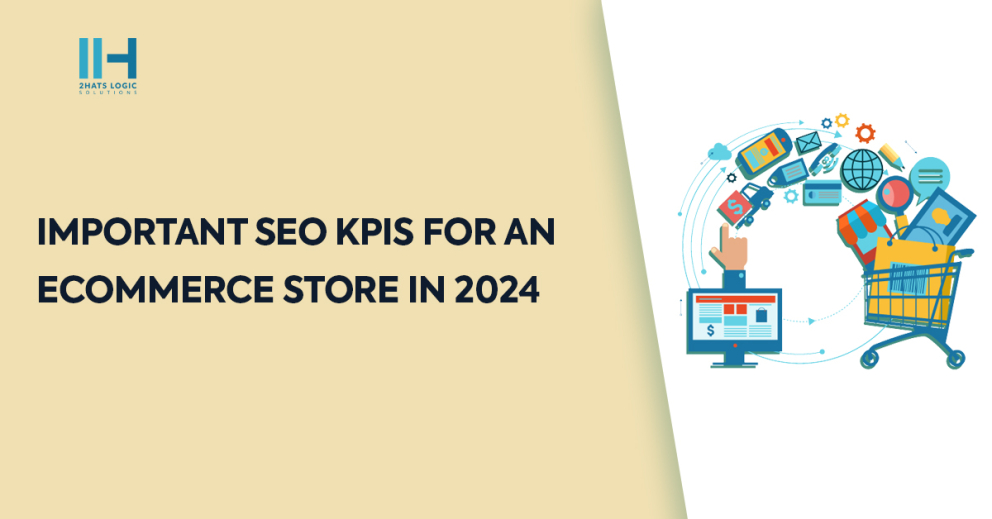Greetings! I'm Aneesh Sreedharan, CEO of 2Hats Logic Solutions. At 2Hats Logic Solutions, we are dedicated to providing technical expertise and resolving your concerns in the world of technology. Our blog page serves as a resource where we share insights and experiences, offering valuable perspectives on your queries.

What are SEO KPIs?
SEO KPIs are used to measure the success of your Search Engine Optimization marketing strategies. They provide insights into:
User Engagement: Engagement results like impressions, followers, and interactions.
Website Visibility: Is your website discoverable by search engines?
Organic Traffic: The traffic that your website drives through non-paid results.
Keyword Rankings: The position of your website for a particular keyword in the search engine.
Conversion Rates: The rate of visitors who completed the page intent, like purchase, or conversion.
You should measure these KPIs, find potential opportunities, use correct conclusions to improve performance and match SEO techniques to the company’s objectives.
Benefits of Implementing SEO KPIs
Implementing SEO KPIs comes with several advantages:
- Informed Decision Making: KPIs give data-driven information to make strategic decisions.
- Performance Measurement: Results of the SEO efforts of a website could be measured using these metrics.
- Identify Improvement Areas: Identify the website’s strong and weak aspects utilizing these KPIs. Improve the necessary areas for performance.
- Achieve Business Goals: Linking objectives with KPIs guarantees that your SEO goals will be oriented towards bringing value.
- Competitive Advantage: KPI data will provide information about your website’s performance. This helps to make strategies to stay ahead of competitors.
Important SEO KPIs for eCommerce Websites
Here are the few KPIs that every eCommerce business should track in 2024:
1. Organic Traffic Metrics
Organic traffic refers to users who click on the website from unpaid search results. A higher the number of organic traffic indicates brand exposure and possible sales. However, to attract visitors, the website must be optimized with relevant keywords and content.
- Organic Visibility: This provides information on how frequently your webpage appears in SERPs compared to your competitors. Google Search Console is a tool for tracking visibility and clicks.
- Click-Through Rate (CTR): The number of users who click on your link in search results. Greater click rates indicate SEO-effective meta descriptions and title tags.
- Keyword Rankings: A website’s position in search engine results for specific keywords.
| Pro Tip Use long-tail keywords to target niche audiences and increase organic traffic. |
2. Conversion Rate Optimization (CRO) Metrics
CRO metrics analyze whether your site is converting visitors into paying customers. These metrics help e-commerce businesses perfect their sales approach from organic traffic.
- Average Order Value (AOV): Analyzing customer spending so that services offered can reflect the customer’s spending.
- Cart Abandonment Rate: Measures the percentage of users who bounce, without making a purchase. Tools, such as exit-intent popups, can even reduce abandonment.
- Conversion Rates by Device: Knowing where your site converts well on mobile or desktop can help you optimize your designs.
3. User Experience Metrics
User experience metrics measure how visitors engage with your site. A good user experience tends to generate better engagement and conversion rates.
- Bounce Rate: The ratio of the total number of site visitors to the number of visitors who have interacted with the site. Bounce rate usually indicates low quality of content or design.
- Average Session Duration: This measures the time users spend engaging with the content, indicating the quality.
- Pages Per Session: The number of pages viewed during a visit reflects the depth of engagement.
- Mobile Responsiveness: As mobile shopping becomes popular. Ensure that your site can effectively load on smartphones and tablets.
| Pro Tip Optimize your site navigation to ensure users find what they need in three clicks or less. |
4. Site Performance Metrics
Site performance metrics measure the speed and functionality of your website’s performance. When a website loads efficiently and works properly, it suggests a better user experience and can even boost its ranking on SEO.
- Page Load Speed: Faster loading pages increase both user experience and rankings. For instance, you can optimize images to improve page speed.
- Site Speed Index: Measure of how the site is doing; it impacts user satisfaction.
- Time to First Byte (TTFB): This measures server response time and impacts the first user experience.
| Pro Tip Use a Content Delivery Network (CDN) to improve page load times globally. |
5. Backlink Profile Metrics
Backlinks are links from other websites that drive traffic to yours. They are a form of endorsement for your site and are basic to building authority in search engines.
- Backlinks: Links from other sites to your site are important for building credibility and authority.
- Authority Score: This is the strength of your backlink profile compared to competitors, which helps to prioritize link-building efforts.
- Link Relevance: Quality and context are more important than the quantity of backlinks.
6. Content Performance Metrics
The metrics would analyze how content quality, user engagement, and conversions. High-performing content is essential for Search Engine rankings and engagement.
- Landing Page Analytics: Know which pages are visited the most to understand user intent.
- Time on Page: Determine how long visitors spend on specific pages to understand user engagement.
- Dwell Time: How long do visitors stay on the page after clicking a search result? The longer, the content is relevant and ranks higher.
- Social Engagement Metrics: Social media interaction proves how well your content performs with your audience.
| Pro Tip Repurpose high-performing blog posts into videos or infographics for broader engagement. |
7. Mobile-Focused Metrics
Mobile optimization is important, as mobile shopping is increasing.
- Mobile Traffic Share: Track the percentage of visitors using mobile devices to access your site.
- Mobile Conversion Rate: Measure how effectively mobile visitors purchase; a low rate might indicate navigation issues.
- Mobile Usability: Ensure easy navigation and intuitive design on mobile to enhance customer experience and reduce bounce rates.
8. Local SEO Metrics
These metrics estimate the website’s visibility and ranking in local search results.
- Local Organic Traffic: Understand your audience and the content they might be interested in.
- Local Keyword Rankings: Track your ranking in local search results to enhance visibility among local customers.
- Google My Business Metrics: A well-managed Google My Business account will increase foot traffic. Optimize your profile to improve local search visibility.
9. E-commerce-Specific Metrics
These metrics are specifically for e-commerce businesses and provide insights into sales performance.
- Product Page Conversion Rate: Determine how many people convert after seeing product pages to help guide content strategy.
- Cart-to-Detail Rate: Determine how many users add things to their baskets versus those who merely examine them; this helps uncover purchasing barriers.
- Average Revenue per User (ARPU): This indicator measures the entire profitability of each user.
10. Competitive Analysis Metrics
These metrics enable you to compare your performance with those of competitors, helping identify market opportunities.
- Competitor Keyword Rankings: Analyze competitors for insights on specific keywords and gaps in your strategy.
- Backlink Profile Comparison: Review competitors’ backlinks to identify link-building opportunities.
- Content Performance Insights: Competitors’ content helps identify trends and high-performing topics in your niche.
| Pro Tip Use competitor gap analysis to identify untapped keyword opportunities. |
Conclusion
To monitor the changing consumer shopping behaviors and trending subjects to maintain continuity in your online business. Careful analysis of SEO KPIs helps e-commerce startups sail in the sea of digital business confidently and gradually enhance visitors, engagement, and conversion. For expert advice, you can contact e-commerce services to improve your website visibility. While the digital competitive arena is overburdened, search engine optimization KPIs become the center of eCommerce success. For any further support, hire a developer.
FAQ
Methods to improve a website's organic visibility?
To drive organic traffic, make sure to centre your current content around relevant keywords, gain backlinks from reputable websites, and make sure your site is mobile-friendly. This way, it will look well on phones and tablets.
What to do if the website conversion rate is low?
Something to think about here is the low conversion rate, so consider improving your product pages with high quality images, and persuasive content. You might also think of the streamlined check-out process to reduce less cart abandonment. Another way is to offer discounts or free shipping to encourage sales.
How to measure the performance of a website?
One way is through content performance measurements that we gain by reviewing page views, time on page and the engagement metrics like likes, comments, and shares on social media platforms.
Why is mobile usability important?
Mobile usability acts as important because a large chunk of online traffic emanates from mobile based devices. If you remember to keep your website user-friendly by giving it an easy navigation and fast loading speed on mobile devices then, you will be able to enhance user experience that consequently will drive a lot of conversions.
Table of contents

Related Articles






